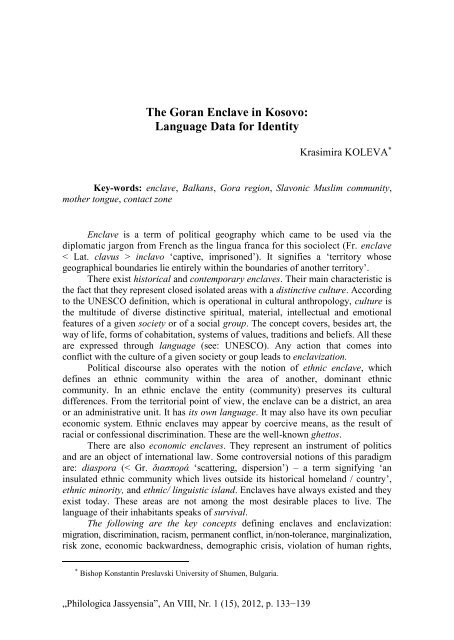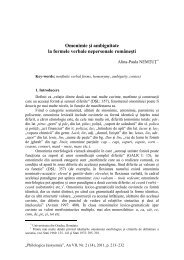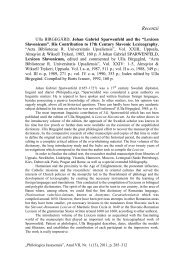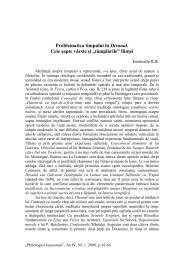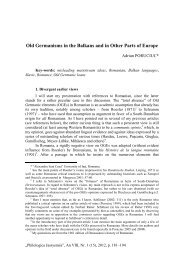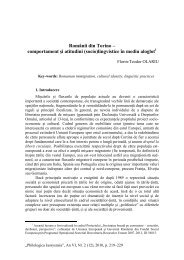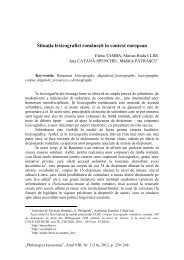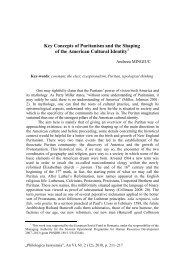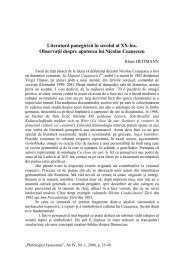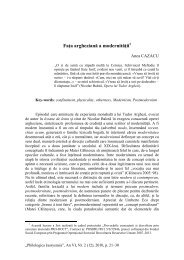O sută de ani de cartografie lingvistică românească - Philologica ...
O sută de ani de cartografie lingvistică românească - Philologica ...
O sută de ani de cartografie lingvistică românească - Philologica ...
Create successful ePaper yourself
Turn your PDF publications into a flip-book with our unique Google optimized e-Paper software.
The Goran Enclave in Kosovo:<br />
Language Data for I<strong>de</strong>ntity<br />
„<strong>Philologica</strong> Jassyensia”, An VIII, Nr. 1 (15), 2012, p. 133−139<br />
Krasimira KOLEVA �<br />
Key-words: enclave, Balkans, Gora region, Slavonic Muslim community,<br />
mother tongue, contact zone<br />
Enclave is a term of political geography which came to be used via the<br />
diplomatic jargon from French as the lingua franca for this sociolect (Fr. enclave<br />
< Lat. clavus > inclavo ‘captive, imprisoned’). It signifies a ‘territory whose<br />
geographical boundaries lie entirely within the boundaries of another territory’.<br />
There exist historical and соntemporary enclaves. Their main characteristic is<br />
the fact that they represent closed isolated areas with a distinctive culture. According<br />
to the UNESCO <strong>de</strong>finition, which is operational in cultural anthropology, culture is<br />
the multitu<strong>de</strong> of diverse distinctive spiritual, material, intellectual and emotional<br />
features of a given society or of a social group. The concept covers, besi<strong>de</strong>s art, the<br />
way of life, forms of cohabitation, systems of values, traditions and beliefs. All these<br />
are expressed through language (see: UNESCO). Any action that comes into<br />
conflict with the culture of a given society or goup leads to enclavization.<br />
Political discourse also operates with the notion of ethnic enclave, which<br />
<strong>de</strong>fines an ethnic community within the area of another, dominant ethnic<br />
community. In an ethnic enclave the entity (community) preserves its cultural<br />
differences. From the territorial point of view, the enclave can be a district, an area<br />
or an administrative unit. It has its own language. It may also have its own peculiar<br />
economic system. Ethnic enclaves may appear by coercive means, as the result of<br />
racial or confessional discrimination. These are the well-known ghettos.<br />
There are also economic enclaves. They represent an instrument of politics<br />
and are an object of international law. Some controversial notions of this paradigm<br />
are: diaspora (< Gr. διασπορά ‘scattering, dispersion’) – a term signifying ‘an<br />
insulated ethnic community which lives outsi<strong>de</strong> its historical homeland / country’,<br />
ethnic minority, and ethnic/ linguistic island. Enclaves have always existed and they<br />
exist today. These areas are not among the most <strong>de</strong>sirable places to live. The<br />
language of their inhabitants speaks of survival.<br />
The following are the key concepts <strong>de</strong>fining enclaves and enclavization:<br />
migration, discrimination, racism, permanent conflict, in/non-tolerance, marginalization,<br />
risk zone, economic backwardness, <strong>de</strong>mographic crisis, violation of human rights,<br />
� Bishop Konstantin Preslavski University of Shumen, Bulgaria.
Krasimira KOLEVA<br />
restrictive agreements, ethnic media, lingua franca for business and social contacts,<br />
i<strong>de</strong>ntity and community crises.<br />
There are numerous enclaves scattered in the Balkans, both in the diachronic<br />
and synchronic aspect. The study of these enclaves has become topical since the<br />
<strong>de</strong>mocratic changes in Eastern Europe and following the disintegration of Yugoslavia.<br />
The Kosovo crisis in 1999 led to the creation of new enclaves, dynamic in number<br />
and status.<br />
The object of this paper is the Gora enclave in the Western Balkans, a part of<br />
the global Bulgarian diaspora. Our field work/research in Kosovo dates back to 2009<br />
and we are still in contact with this enclave.<br />
Only lately, mostly as a result of objective causes, has this area become an<br />
object of interest for researchers. The scarcity of field data for about half of a<br />
century has been partly balanced by some local initiatives which resulted in the<br />
publication of collective and individual works (Dokle 2007 et al.).<br />
By the end of the twentieth century, after the breakup of Tito’s Yugoslavia,<br />
Gora had become an object of research for Serbian scholars. The results were<br />
presented at the interdisciplinary round table in 2000 in Belgra<strong>de</strong>. The subtitle of the<br />
collective volume issued two years later is representative: Gor<strong>ani</strong>es, Muslims and<br />
Turks in the Šar (Shar) Mountain Župas (Parishes) of Serbia: Problems of the<br />
Actual Living and Survival Conditions (Gor<strong>ani</strong>es 2002). The next similar Belgra<strong>de</strong><br />
project was issued un<strong>de</strong>r a title even more emblematic of the social-political<br />
situation: Kosovo and Metohija. Living in the Enclave. Its results were published in<br />
Belgra<strong>de</strong> in 2007 (Kosovo 2007). One can estimate the politicized discourse in the<br />
theses in these volumes.<br />
At the same time Bulgarian scholars from Sofia University and the Bulgarian<br />
Aca<strong>de</strong>my of Sciences involved in the study of Balkan diasporas started their work as<br />
part of the international project Balkan traditions: a community of cultures, religions<br />
and languages with the contribution of impartial Serbian Balkanologists. As part of<br />
this project, Sofia hosted the 2005 international conference on the topic of Bulgarian<br />
islands in the Balkans followed by the publication of a volume with the same title<br />
(Ostrovi 2007). As part of this project, research is being carried out in the Alb<strong>ani</strong>an<br />
part of Gora by Petja Asenova, the director of the project. The researcher <strong>de</strong>scribes<br />
the dialect of the Alb<strong>ani</strong>an Gora (Kukёs) as an isolated Bulgarian dialect (Asenova<br />
2005: 73–78).<br />
Today, within the large-scale European project Kleiner Balkansprachatlas,<br />
research is being conducted by Balkanologists in that area un<strong>de</strong>r the guidance of<br />
Andrei Sobolev.<br />
In 2007 an ambitious still ongoing project was started at Shumen University:<br />
Ethnopolitics of language and languages of politics in the Balkans. We utilize an<br />
interdisciplinary approach; the data base inclu<strong>de</strong>s all information sources. The<br />
scholarly methodology has been taken from cultural anthropology, contact<br />
linguistics, social psychology, etc. The linguistic objectives of this project are<br />
synchronized with other European projects – Kleiner Balkansprachatlas, in Balkan<br />
studies, and EUROJOS (Językowo-kulturowy obraz świata Słowian i ich sąsiadów<br />
na tle porównawczym), oriented toward Slavonic studies.<br />
134
The Goran Enclave in Kosovo: Language Data for I<strong>de</strong>ntity<br />
The enclave character of Gora owes its existence mostly to various factors<br />
which relate to problems of community i<strong>de</strong>ntity:<br />
− natural causes (characteristics of the relief);<br />
− still active long and complex inner and outer-external dynamic social<br />
phenomena.<br />
These factors influence in various ways the living standard in the community,<br />
which can be best <strong>de</strong>fined as struggle for survival.<br />
Today the community inhabits the periphery areas of three young multiethnic<br />
states: Kosovo (Prizren Gora), Аlb<strong>ani</strong>a (Kukës Gora) and two villages in Macedonia<br />
(Urvich and Jelovene). This fact does not represent an obstacle for communication<br />
for the population in this periphery. From a geographical perspective, this is a<br />
naturally isolated area, which contributed to its enclavization in the past. Gora is<br />
difficult to reach. It is surroun<strong>de</strong>d by the high mountain ranges of Shar Pl<strong>ani</strong>na,<br />
Vratsa, Korab and Koritnik. It has also water boundaries – the rivers Beli Drin,<br />
Bistrica, Mlika and other tributaries of the Plava River.<br />
The landscape is one of the causes of the poor infrastructure and the related<br />
economic marginalization of this area. This fact generated the outer and inner forced<br />
migration of the population. Life in the village, within the traditional paradigm of a<br />
closed community, is replaced by a different type of living. Before migration,<br />
working-age men migrated in several stages, a process known as gurbetchijstvo<br />
(‘leaving in or<strong>de</strong>r to earn’) with their sons, whereas today we are faced with the<br />
migration of whole families. The connection with one’s kin was ma<strong>de</strong> by new<br />
houses built as a sign of prosperity and by the yearly summer holiday spent in the<br />
home village, tightly connected to the traditional festivals, commonly turned into a<br />
marriage season. This type of family culture is still preserved, connections between<br />
relatives and co-villagers, in<strong>de</strong>pen<strong>de</strong>nt of their location, are very strong.<br />
Communication in the mother tongue is compulsory in the community.<br />
Most of the territory inhabited by the community lies in Kosovo, which<br />
represents the arena of long continuing ethnic conflicts. The nativity trend in<br />
Kosovo and the turning of the <strong>de</strong>mographic factor into politics represent the cause of<br />
the emergence of villages with mixed population, as well as the cause of the new<br />
enclavization of the area. The alb<strong>ani</strong>zation of Gora is increasingly stronger. One<br />
factor is the Alb<strong>ani</strong>an “wedge” in Opole, between Dragash Gora and Zhupa. The<br />
municipal centre of Dragash is already dominated by Kosovars. The new “patriotic<br />
mainstream” (Prizren – Durrës), which gives Kosovo access to the Adriatic Sea, and<br />
represents an economic enclave, gives a further push to the Alb<strong>ani</strong>zation of Gora.<br />
Moreover, all this is accomp<strong>ani</strong>ed by intolerance. Ethnic pressure is triggered<br />
by economic pressure, which substitutes the significant local community symbols of<br />
material culture and traditional means of sustenance, such as Sharpl<strong>ani</strong>nska brynza,<br />
byurek (tasty salted pie), boza (a thick sweet-sour drink ma<strong>de</strong> of millet), halva (a<br />
special yellow-white Oriental sweet ma<strong>de</strong> of sunflower seeds or sesame),<br />
kebapcheta (spicy thick mince-meat coal-roasted fingers) and even building as a<br />
“tra<strong>de</strong> mark” for whole generations. The Hashim and Agim Ceku comp<strong>ani</strong>es are<br />
turning the Gora enclave from a cultural into an economic one by means of the<br />
region-specific typical economic instruments – drugs and illegal trafficking.<br />
135
Krasimira KOLEVA<br />
It is difficult to make an estimate of the number of the community members<br />
today. The data for 1981, 1991 and 2002 point to a ten<strong>de</strong>ncy toward a rather<br />
puzzling <strong>de</strong>crease. This is a result not only of the increasing emigration, but also of<br />
the <strong>de</strong>claration of nationality, which <strong>de</strong>pends on the social and economic climate in<br />
the country. The phenomenon of skrivena m<strong>ani</strong>na (‘hid<strong>de</strong>n nationality’) of<br />
totalitarian Yugoslavia is still present in the social behavior of the members of the<br />
minority, who have taught themselves to mimic in or<strong>de</strong>r to survive and to get<br />
opportunities on the labor market. This has proved to be possible for the generations<br />
which have learned not only Serbian, but, above all, Alb<strong>ani</strong>an, against the official<br />
bilingualism stipulated in the 2008 Constitution of Kosovo (Koleva 2011: 78−90).<br />
The continuously infringed ethnic and confessional pluralism, life un<strong>de</strong>r<br />
totalitarian ethno-confessional repressions forces the minority to infiltrate insi<strong>de</strong> the<br />
majority; this conveniently counts as disintegration, as related to the community. In<br />
this situation, the Serbian community un<strong>de</strong>rgoes total enclavization. The 2011<br />
European census played an important part in the economic and social planning, in<br />
the <strong>de</strong>velopment of each state in Europe as a whole. The European Commission<br />
requires the census to resort to the same internationally recognized criteria. In or<strong>de</strong>r<br />
to avoid doubling, one takes into account the constant living in the given state longer<br />
than one year. The questions regarding ethnic belonging and religious <strong>de</strong>nomination<br />
are not compulsory in the census. After the 2011 elections in Kosovo, the<br />
Committee charter regions of the European Commission (Europa 2011) has “noticed<br />
with concern that one witnesses a serious lack of dialogue and peaceful<br />
reconciliation between the ethnic groups, as well as a lack of protection and<br />
integration of minorities, particularly of the Kosovar Serbians” (art. 116). Moreover,<br />
the Committee, “has noted with great concern the repeated irregularities, illegal<br />
practices and the falsification during the latest election, which called for<br />
supplementary elections, and regretfully sees this as a clear sign of the incomplete<br />
electoral maturity of the state” (art. 117). Un<strong>de</strong>r such ignorance of the Constitution<br />
and some agreements, including the hum<strong>ani</strong>tarian Framework Convention for the<br />
Protection of National Minorities, the Bulgarian community in Gora-Kosovo, as an<br />
object of pressure and m<strong>ani</strong>pulative interest from the si<strong>de</strong> of the neighbors, until<br />
recently <strong>de</strong>prived of any support from Bulgaria, is getting more and more separated<br />
in the social perspective. Nevertheless, the Gora community does not lose its main<br />
characteristics as an ethnic group.<br />
The processes of consolidation within the community on the whole territory<br />
come out as a reaction against disintegration and ethnic mimicry. They clearly<br />
illustrate the features of national revival – a movement which has not inclu<strong>de</strong>d Gora.<br />
An intelligentsia is being shaped, interest in local history is rising, books are being<br />
published, regional media appear, and, most importantly, money is being invested<br />
not only in new houses, but also in business initiatives, mostly in education. There is<br />
a solid interest in the study of the standard mother language and in getting education<br />
in Bulgaria. The reconnection to the severed homeland takes place by the increasingly<br />
active presence of <strong>de</strong>mocratic processes in the Balkans, initiated by the Bulgarian<br />
state. The presence of the Gora Association of Bulgarians in the world is a factor of<br />
the latest years. Despite the fact that, in the near past, Gora was consi<strong>de</strong>red to be a<br />
Trojan horse because of its survival behavior by ethnic mimicry, this enclave<br />
136
The Goran Enclave in Kosovo: Language Data for I<strong>de</strong>ntity<br />
community is finding ways to cope with the dynamics of social time and to assert<br />
itself through a complex of original culture features.<br />
The following primordial features characterize ethnic social connections trough:<br />
– belief in a common origin and not necessarily through the fact of a common<br />
origin → myths of a common origin;<br />
– memory, as supporting ethnicity – symbols, spiritual space, memories –<br />
rather not as a positive process, but as an interest in one’s own i<strong>de</strong>ntity;<br />
– the presence of a collection of narratives which build the i<strong>de</strong>ntity and are<br />
related to the genealogy of tradition and to the territory of the ancestors.<br />
In practice, ethnic i<strong>de</strong>ntity and ethnic personality clearly represent overlapping<br />
categories. The integrating forces which help to preserve the ethnos, to crystallize<br />
some knowledge about it and its tradition are: language; spiritual culture (traditions,<br />
customs and beliefs); a common origin and historical memories; a common<br />
territory. The most conservative are traditions, which have a synchretic character as<br />
a result of a <strong>de</strong>nominational co<strong>de</strong> that was changed, late and in a coercive manner,<br />
from pag<strong>ani</strong>sm through orthodox Christi<strong>ani</strong>ty to a heterodox Muslim practice. Un<strong>de</strong>r<br />
the condition of today’s Alb<strong>ani</strong>zation of Gora and the more recent Turkicization by<br />
a massive offensive of Turkish capital, Shiizm is an original “wall” for aggressive<br />
cultural influences. The behavior of ethnic i<strong>de</strong>ntity shows an emphatic bent toward<br />
ritual; this is mostly true about ritual of the life cycle such as birth and circumcision,<br />
which are commonly performed before St. George’s Day. The wedding ceremonies<br />
(although more mo<strong>de</strong>rn on an everyday level) inclu<strong>de</strong> <strong>de</strong>eply archaic, authentic<br />
magical and religious practices. Even though the economic and social life in the<br />
villages in Gora already belongs to the autarchic (‘self-sufficient”) type, the<br />
population maintaining active communication with the outer (globalized) world,<br />
there still is a “wall” between them and the people of neighboring villages.<br />
Linguistic behavior as a generalization of ethnic personality is undoubtedly<br />
the most interesting of all. We accept the mother language of the Slavic population<br />
of Gore as part of the Bulgarian-Macedonian dialect continuum located in the<br />
contact zone between the two still large indigenous language continua – the<br />
Alb<strong>ani</strong>an one in the North-West and the Serbian one in the East. Diachronically,<br />
linguistic contacts took place with the Arom<strong>ani</strong>an language, which one can see in<br />
onomastics, as well as with Turkish, which have again become active.<br />
The “others”, including the neighbors, use as ethnonyms a rather wi<strong>de</strong> range<br />
of exonyms in regard to the Gora community:<br />
– Alb<strong>ani</strong>ans – Goran (goranë), Torbesh (torbeshë) and Potur (poturë);<br />
– Serbians – Gòranci, Boshnjaci, Turci;<br />
– Macedonians – Makedonski pomaci;<br />
– Bulgarians – Gòr<strong>ani</strong>.<br />
The language spoken in Gore is called, by attributive <strong>de</strong>rivation, gorançe,<br />
gòranski, makedonski, pomashki, boshnjashki, arhaichna forma na bylgarskija ezik,<br />
and the аlphabet in use (Latin, in keeping with the Alb<strong>ani</strong>an mo<strong>de</strong>l) – gor<strong>ani</strong>ca. The<br />
community has a tolerant attitu<strong>de</strong> only toward the names <strong>de</strong>rived from the toponym<br />
Gora and it would rather use its own <strong>de</strong>finition for the language - gòrski, by which it<br />
separates itself from the Serbians. Often in the communication with other communities<br />
137
Krasimira KOLEVA<br />
it uses the collocation star nash jezik (‘our old language’) in <strong>de</strong>signating the local<br />
mother tongue.<br />
This complicated name loa<strong>de</strong>d with possessive semantics casts a bridge to a<br />
unique ethnic self-<strong>de</strong>finiton of the community and its language – nàshinski =<br />
nàshinci and nàshinski, corresponding to its alphabet – (nàshenica).<br />
This autonym corresponds to the Alb<strong>ani</strong>an language, in which the adverbial<br />
radical nashk serves to mark the Slavic element, that is, the non-Alb<strong>ani</strong>an one, and it<br />
inclu<strong>de</strong>s binary oppositions (Demiraj 2007):<br />
– another origin: Alb<strong>ani</strong>an ~ Slavic;<br />
– a language of a different origin: Alb<strong>ani</strong>an ~ Slavic (in a broad sense);<br />
– another belief / <strong>de</strong>nomination;<br />
– traditions of life and representations of values: Alb<strong>ani</strong>an ~ Slavic / Slavonic;<br />
– other cultural traditions / written culture: Alb<strong>ani</strong>an ~ Slavonic / Slavic / an;<br />
– general / limited life living space = ‘neighbor’.<br />
The endonym (аutonym) of nashici represents an ethnic marker of a small<br />
enclave community which survives in a complex, dynamic and not totally secured<br />
contact zone, un<strong>de</strong>r constant pressure from its neighbors, with whom it shares some<br />
common points in cultural contact:<br />
– a close language-linguistic relationship – with the rest of the Slavic<br />
language in the area;<br />
– confessional similarity – with the Alb<strong>ani</strong>an sea of Muslims.<br />
Nevertheless, one can find a point of contact/crossing between two types of<br />
difference: all indigenous ethnoi belong to the complex ethno-linguistic concept of<br />
Homo balk<strong>ani</strong>cus. At the same time, the ambivalent ethnic co<strong>de</strong> also represents a<br />
high i<strong>de</strong>ntification with the community, with all the community members. This is<br />
reflected in the semantics of the plural personal-pronominal form for the first person<br />
МЬІ / ’we’ (= Я ‘I’ + ВЬІ ‘you, thee’ + ОНИ ‘they’).<br />
As a conclusion, language strengthens ethnic self-awareness/consciousness<br />
and the feeling of self-i<strong>de</strong>ntity represents a part of collective i<strong>de</strong>ntity. This can be<br />
represented by the following formula: стоя зад тях / stoja zad tjah (‘to stand by<br />
them’), which shows that the community can become monolithic even in its existence<br />
as an enclave.<br />
References<br />
Asenova 2005: Petja Asenova. Arhaizmi i balk<strong>ani</strong>zmi v edin izoliran balgarski govor<br />
(Kukaska Gora, Alb<strong>ani</strong>a), in 10 godini specialnost “Balk<strong>ani</strong>stika”, Sofia, Sv. Kliment<br />
Ohridski.<br />
Bulg. Association: http://www.assobulg.com.<br />
Demiraj 2007: Bardhyl Demiraj. Shqa im Alb<strong>ani</strong>schen (Eine ethnolinguistische Fallstudie),<br />
in http://www.alb<strong>ani</strong>an.dir.bg/studii/ezik/Demiraj_Shqa-im-Alb.pdf<br />
Dokle 2007: Nazif Dokle. Reçnik Goransko (Nashinski) – Albanski. Fjalor Gorançe<br />
(Nashke) – Shqip, Sofia, BAN.<br />
Europa 2011: http://europa.eu/about-eu/institutions-bodies/cor/in<strong>de</strong>x_bg.htm<br />
Gor<strong>ani</strong>es 2002: Gor<strong>ani</strong>es, Muslims and Turks in the Šar (Shar) Mountain Župas (Parishes)<br />
of Serbia: Problems of the Actual Living and Survival Conditions, Belgra<strong>de</strong>, SASA.<br />
Koleva 2011: Krasimira Koleva, Bolgaro-makedonskij ethnokul’turnyj i jazykovoj areal<br />
Zhupa (Kosovo) segodnja, in Bolgarsьkij shtorіchnik, VII, Kiïv, VIPOL.<br />
138
The Goran Enclave in Kosovo: Language Data for I<strong>de</strong>ntity<br />
Кosovо 2007: Kosovo and Metohija. Living in the Enclave, Belgra<strong>de</strong>, SASA.<br />
Ostrovi 2007: Balgarskite ostrovi na Balk<strong>ani</strong>te, Sofia, Figura.<br />
UNESCO: http://www.unesco.org.<br />
The Goran Enclave in Kosovo: Language Data for I<strong>de</strong>ntity<br />
Gora is an enclave on the territory of western Balkans (Kosovo, Alb<strong>ani</strong>a and<br />
Macedonia). It is a region with a mixed population. The small community of Muslim Gorans<br />
speaks a Slavic idiom specific to the western Balkan area in which three large language<br />
continua are in contact: Alb<strong>ani</strong>an, Macedonian-Bulgarian and Serbian. The mother tongue of<br />
the Gorans is exclusively a home language. Gorans and the Goran language are concepts<br />
that bear an ethno-i<strong>de</strong>ological content, at a time when politics has been accomp<strong>ani</strong>ed by<br />
ethnic conflicts. The Goran community is <strong>de</strong>termined by features that are common and<br />
value-la<strong>de</strong>n for all speakers. This paper is a result of the author’s current specialized research<br />
projects.<br />
139


